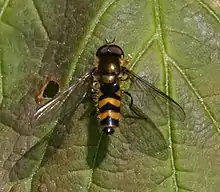Fagisyrphus
Fagisyrphus cinctus is a European species of hoverfly. This species has a muddled taxonomic history. Older authors treated it as a member of the genus Melangyna, and later sources in Meligramma (as either a separate genus or a subgenus of Melangyna), but the most recent sources recognize it as the sole species in its own monotypic genus, Fagisyrphus.[1]
| Fagisyrphus | |
|---|---|
 | |
| male | |
| Scientific classification | |
| Domain: | Eukaryota |
| Kingdom: | Animalia |
| Phylum: | Arthropoda |
| Class: | Insecta |
| Order: | Diptera |
| Family: | Syrphidae |
| Subfamily: | Syrphinae |
| Tribe: | Syrphini |
| Genus: | Fagisyrphus |
| Species: | F. cinctus |
| Binomial name | |
| Fagisyrphus cinctus (Fallén, 1817) | |
| Synonyms | |
| |
Description
External images
For terms see Morphology of Diptera
Wing length 6 ·25–8·75 mm. Tergites 3 and 4 with yellow to orange bands. Tergite 2 with two yellow, triangular marks. Elongate abdomen.
See references for determination.[2]
[3]
[4]
[5]
The male genitalia are figured by Dusek and Laska (1967).[6] The larva is figured in colour by Rotheray (1994).[7]
Distribution
Palearctic Fennoscandia South to Iberia and the Mediterranean. Ireland Eastwards through Europe into European Russia, the Crimea and Turkey. [8][9]
Biology
Habitat: Fagus and Quercus woodland.[10] Flowers visited include white umbellifers, Acer pseudoplatanus, Crataegus, Ligustrum, Malus sylvestris, Prunus spinosa, Rubus idaeus, Salix, Sambucus nigra, Sorbus aucupariae, Urtica dioica, Viburnus opulus.[11] The flight period is April to July in two generations. The larva feeds on aphids.
References
- Skevington, J.H.; Locke, M.M.; Young, A.D.; Moran, K.; Crins, W.J.; Marshall, S.A (2019). Field Guide to the Flower Flies of Northeastern North America. Princeton Field Guides (First ed.). Princeton, New Jersey: Princeton University Press. p. 512. ISBN 9780691189406.
- Van Veen, M. (2004) Hoverflies of Northwest Europe: identification keys to the Syrphidae. 256pp. KNNV Publishing, Utrecht.addendum
- Van der Goot,V.S. (1981) De zweefvliegen van Noordwest - Europa en Europees Rusland, in het bijzonder van de Benelux. KNNV, Uitgave no.32: 275pp. Amsterdam.
- Bei-Bienko, G.Y. & Steyskal, G.C. (1988) Keys to the Insects of the European Part of the USSR, Volume V: Diptera and Siphonaptera, Part I. Amerind Publishing Co., New Delhi. ISBN 81-205-0080-6.
- Coe, R.L. (1953) Diptera: Syrphidae. Handbks.ident.Br.insects, 10(1): 1-98. R.ent.Soc.London. pdf
- Dusek, J. & Laska, P. (1967) Versuch zum aufbau eines Naturlichen Systems mitteleuropaischer Arten der Unterfamilie Syrphinae (Diptera). Acta sc.nat.Brno, 1: 349-390.
- Rotheray G., 1993 Colour Guide to Hoverfly Larvae Diptera, Syrphidae in Britain and Europe Dipterists Forum pdf
- Fauna Europaea
- Peck, L.V. (1988) Syrphidae. In: Soos, A. & Papp, L. (eds.) Catalogue of Palaearctic Diptera, 8: 11-230. Akad.Kiado, Budapest.
- Speight, M.C.D. (2011). "Species accounts of European Syrphidae (Diptera)" (PDF). Syrph the Net, the Database of European Syrphidae. 65: 285pp.
- de Buck, N. (1990) Bloembezoek en bestuivingsecologie van Zweefvliegen (Diptera, Syrphidae) in het bijzonder voor België. Doc.Trav. IRSNB, no.60, 1-167.